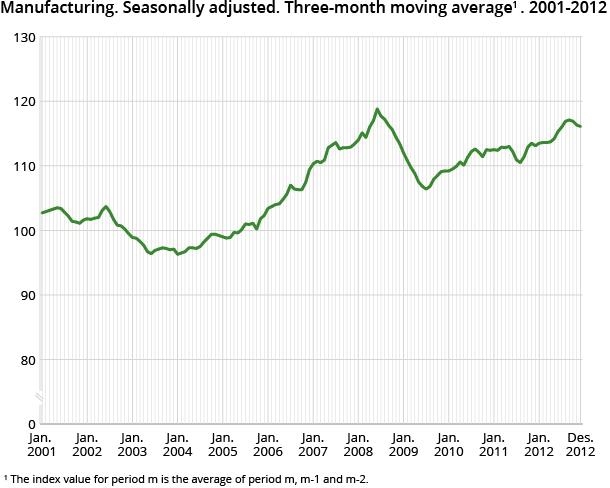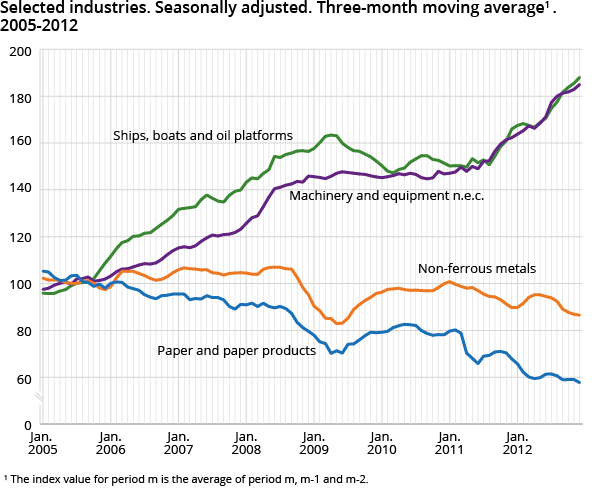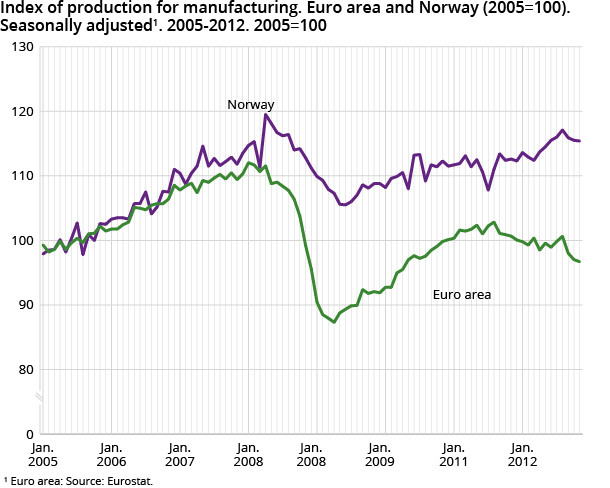Content
Published:
This is an archived release.
Oil-driven growth in manufacturing
Production in manufacturing went up 2.7 per cent from 2011 to 2012, according to working-day adjusted figures. The gap between the different industries increased in 2012.
| Seasonally adjusted | Calender adjusted1 | Weights2 | ||
|---|---|---|---|---|
| Monthly change | Three-month change | Twelve-month change | ||
| December 2012 / November 2012 | October 2012 - December 2012 / July 2012 - September 2012 | December 2012 / December 2011 | ||
| 1Adjusted for working-days and for public holidays in Norway. | ||||
| 2The weights are updated annually, and are valid for the entire year. | ||||
| Extraction, mining, manufacturing and elec | 1.1 | -1.4 | 0.0 | 100.0 |
| Extraction and related services | 1.2 | -0.6 | -3.8 | 66.7 |
| Mining and quarrying | 2.7 | 24.9 | 13.5 | 0.7 |
| Manufacturing | 0.3 | -0.9 | 2.8 | 24.8 |
| Food, beverage and tobacco | 1.7 | -0.1 | 7.2 | 4.5 |
| Refined petro., chemicals, pharmac. | -3.5 | -4.8 | -1.0 | 2.9 |
| Basic metals | 0.1 | -3.1 | -2.4 | 1.3 |
| Machinery and equipment | 1.5 | 2.0 | 14.8 | 3.1 |
| Ships, boats and oil plattforms | 4.7 | 3.5 | 13.8 | 2.2 |
| Electricity, gas and steam | 4.5 | -9.1 | 14.1 | 7.8 |
Industries such as machinery and equipment, and ships, boats and oil platforms had a significant growth and a record-high production in 2012. This was related to the strong growth in investments within the Norwegian petroleum sector over time, and a high level of unfilled orders. There was also growth in fabricated metal products. The production in industries such as paper and paper products, basic chemicals and basic metals had a clear decline in 2012 compared with 2011. A high exchange rate, weak international market and a high stock of goods all had a negative impact on industries such as non-ferrous metals. The differences between industries linked to the Norwegian oil and gas industries, and more traditional Norwegian export industries have thereby continued to increase in 2012. The production of food products showed growth in 2012 compared with 2011. Larger slaughter volumes of Norwegian farmed salmon have contributed to a growth in the production of fish and fish products. There has also been an increase in fodder production for Norwegian farmed salmon.
Decline in the fourth quarter of 2012
The output in manufacturing saw a decline of 0.9 per cent from the third to the fourth quarter of 2012, according to seasonally-adjusted figures. Production of basic chemicals and basic metals experienced a drop, while machinery and equipment, together with ships, boats and oil platforms had a production growth.
From November to December 2012
The production in Norwegian manufacturing went up 0.3 per cent from November to December 2012, according to seasonally-adjusted figures. There has been a continued growth in machinery and equipment and in ships, boats and oil platforms, while paper and paper products and non-ferrous metals saw a decrease in production.
Norway and the euro area
There was a 2.4 per cent increase in Norwegian manufacturing output from November 2011 to November 2012, according to working-day adjusted figures. Industrial production in the euro area decreased by 4.2 per cent in the same period, according to figures published by Eurostat.
Interpretation of seasonally-adjusted figuresOpen and readClose
In order to facilitate the interpretation of the short-term development, the index of production publishes three-month moving averages of the seasonally-adjusted figures. We normally compare the latest non-overlapping three-month periods, for instance November 2012 to January 2013 compared with August October 2012. Seasonally-adjusted monthly changes must be interpreted with caution.
Number of hours worked Open and readClose
The numbers of hours worked by contracted workers is included in the calculation of the Index of production for the first time from January 2012 onwards. These numbers are collected from January 2011. The inclusion of numbers of hours worked by contracted workers may lead to somewhat larger short-term fluctuations for some industries. At the same time, the development will be more accurately measured for industries where hours worked are used as an indicator. Industries like ships, boats and oil platforms and repair and installation of machinery typically use contracted workers in periods with high activity.
New projectsOpen and readClose
New projects in industries with hours worked as an indicator are intercepted at start-up, as long as the project is carried out by establishments covered by the sample. It is the total number of hours carried out in the survey period that is reported, regardless of which project the hours are spent on.
Contact
-
Production and turnover
E-mail: prodoms@ssb.no



